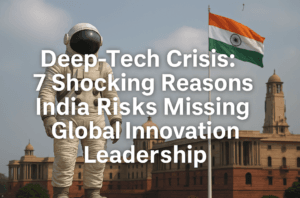Deep-Tech Crisis: 7 Shocking Reasons India Risks Missing Global Innovation Leadership
Piyush Goyal’s critique of India’s startup ecosystem highlights a critical gap: while consumer-driven ventures thrive, deep-tech innovation lags, jeopardizing India’s global tech leadership ambitions. Despite producing world-class talent, systemic barriers—inadequate R&D funding (just 0.7% of GDP), risk-averse investors, and outdated education systems—stifle breakthroughs. China’s strategic investments in EVs, AI, and semiconductors starkly contrast India’s reliance on low-risk sectors like food delivery.
Yet, pockets of excellence—Agnikul Cosmos in space tech, Log9 Materials in EV batteries—prove potential. Bridging this gap demands bold reforms: boosting R&D spending to 2% of GDP, fostering industry-academia collaboration, incentivizing patient capital, and celebrating risk-taking. For India to transition from incremental “jugaad” to transformative innovation, aligning policy, education, and cultural mindset isn’t optional—it’s a strategic imperative for Viksit Bharat and global relevance.

Deep-Tech Crisis: 7 Shocking Reasons India Risks Missing Global Innovation Leadership
Commerce and Industry Minister Piyush Goyal’s recent critique of India’s startup ecosystem has ignited a crucial conversation. At the Startup Mahakumbh, he questioned the focus on consumer-centric ventures—food delivery apps, boutique brands, and quick commerce—while urging a pivot toward deep-tech innovation. His comparison with China, where startups thrive in electric vehicles (EVs), semiconductors, and AI, underscores a pressing challenge: India’s struggle to cultivate groundbreaking technologies despite its vast talent pool. As the nation eyes Viksit Bharat (Developed India) by 2047, addressing systemic barriers to innovation is no longer optional—it’s existential.
The Startup Boom: Growth Without Depth
India’s startup ecosystem, the world’s third-largest, boasts over 100 unicorns and a valuation exceeding $350 billion. However, this growth is lopsided. Consumer tech dominates, driven by India’s vast market and digital adoption. While companies like Paytm and PhonePe revolutionized payments, few have ventured into deep tech—sectors requiring cutting-edge R&D, such as AI, quantum computing, or advanced manufacturing. The Global Innovation Index 2024 ranks India 39th, far behind China (11th), reflecting this imbalance.
Why Deep-Tech Lags: Systemic Challenges
- Funding Gap: While India’s tech investments totaled $160 billion (2014–2024), China allocated $845 billion during the same period. Initiatives like “Made in China 2025” funnel billions into strategic sectors, whereas India’s Rs 10,000 crore IndiaAI Mission and Fund of Funds for deep tech lack comparable scale. Early-stage startups often face a “valley of death” due to scarce patient capital.
- Education and Research Deficit: India produces 1.5 million engineers annually, but only 15% are employable in tech roles, per NASSCOM. Universities rarely feature in global top-100 rankings, and R&D spending stagnates at 0.7% of GDP—below China’s 2.4% and the US’s 3.5%. Without world-class labs and industry-academia collaboration, breakthrough innovations remain elusive.
- Risk-Averse Culture: Indian investors prioritize quick exits over long-term bets. While U.S. VCs back moonshots like SpaceX (20 years to profitability), India’s ecosystem favors low-risk models. Regulatory hurdles, like the erstwhile angel tax, further deter innovation.
- Brain Drain: Indian talent thrives in Silicon Valley—leading firms like Google, Microsoft, and NVIDIA—but domestic challenges, from bureaucracy to infrastructure gaps, discourage repatriation of skills.
Glimmers of Hope: Pioneering Indian Deep-Tech
Despite hurdles, pockets of excellence emerge:
- Space Tech: Startups like Agnikul Cosmos and Skyroot Aerospace are democratizing satellite launches with cost-effective solutions.
- Climate Tech: Companies such as Log9 Materials innovate in EV batteries, while Atomgrid advances green hydrogen production.
- AI and Cybersecurity: Sarvam AI develops Indic-language AI models, and Silence Laboratories pioneers privacy-focused encryption.
NASSCOM reports deep-tech startups raised $1.6 billion in 2024—a 78% YoY jump. Yet, these remain exceptions in a consumer-tech-dominated landscape.
Building a Deep-Tech Ecosystem: A Blueprint
Government as Catalyst:
- Increase R&D spending to 2% of GDP by 2030, with grants for high-risk projects.
- Expand the Production-Linked Incentive (PLI) scheme to include R&D-intensive sectors like semiconductors.
- Simplify IP laws and streamline approval processes for tech trials.
Education Overhaul:
- Forge global partnerships (e.g., IIT-MIT collaborations) to upgrade curricula and research facilities.
- Incentivize corporate R&D labs in universities, following the Bell Labs model.
Cultural Shift:
- Promote risk-taking through tax breaks for long-term VC investments and failure-friendly policies.
- Launch national campaigns (akin to “Chandrayaan spirit”) to celebrate deep-tech innovators.
Industry-Academia Synergy:
- Create innovation hubs (e.g., Bengaluru’s AI Cluster) where startups, corporates, and researchers co-develop solutions.
- Leverage diaspora expertise via mentorship programs and dual research roles.
Conclusion: Innovation as National Imperative
Goyal’s critique is a wake-up call. For India to lead the 21st-century tech race, it must transition from incrementalism to transformational innovation. China’s rise in EVs and renewables, and the U.S.’s AI dominance, highlight the stakes. As Prime Minister Modi envisions a Viksit Bharat, fostering deep tech isn’t just about economic growth—it’s about strategic autonomy and global influence. The time for “jugaad” is over; the era of “jagrukta” (awareness) must begin. By aligning policy, education, and capital, India can turn its demographic dividend into an innovation dividend—one breakthrough at a time.
You must be logged in to post a comment.